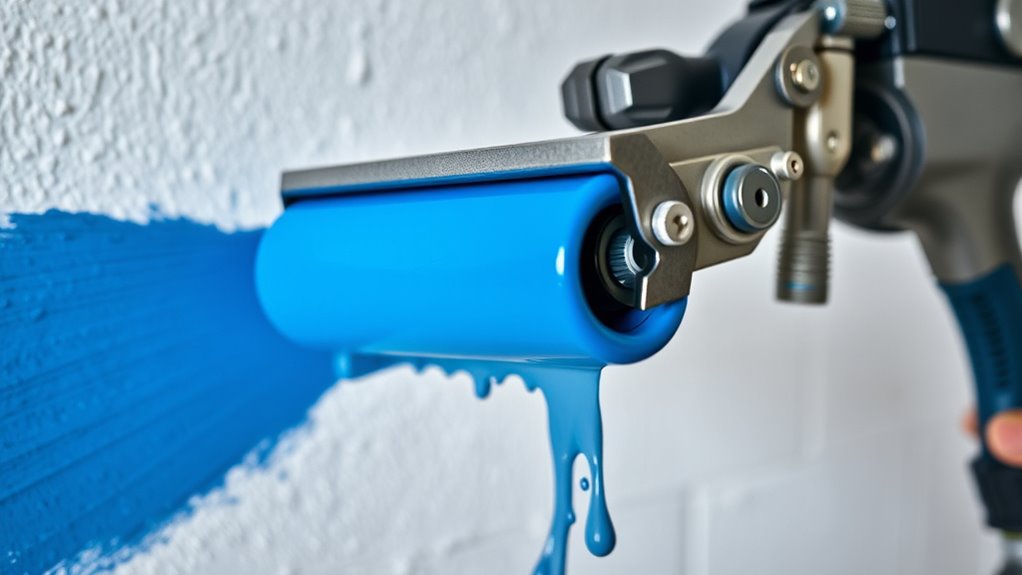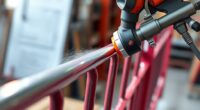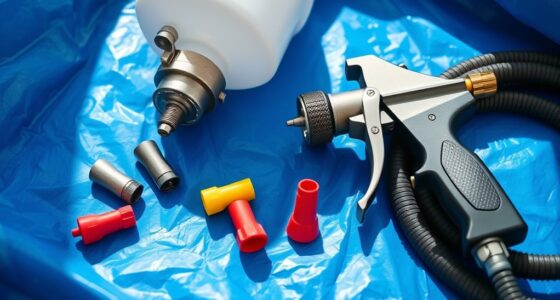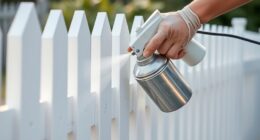Using roller attachments for airless sprayers lets you combine the speed of spraying with the control and smooth finish of rolling. They’re ideal for large surfaces like walls and ceilings, saving time and effort while providing a professional look. Rollers reduce overspray and mess, making indoor projects easier. If you want to know when rolling with an airless beats spraying, keep going—you’ll discover valuable tips for perfect results.
Key Takeaways
- Roller attachments provide a smoother, more even finish in confined or detailed areas where spraying may be less precise.
- Rolling with attachments reduces overspray and mess, making cleanup easier and ideal for indoor projects.
- For large, flat surfaces, rolling can be faster and more efficient than spraying, especially with a high-quality roller attachment.
- When applying thicker coats or working near trim and fixtures, rolling offers greater control and precision.
- Combining spraying speed with rolling control enhances overall finish quality and reduces the need for touch-ups.

If you’re looking to improve the efficiency and quality of your painting projects, roller attachments for airless sprayers can be a game-changer. These tools combine the speed of spraying with the control and finish of traditional rolling, offering a versatile solution that can save you time and effort. When you switch to using a roller attachment, you’re fundamentally turning your airless sprayer into a high-powered roller, allowing you to cover large surfaces quickly without sacrificing the smoothness and coverage you’d expect from manual rolling. This setup is particularly useful for projects that involve walls, ceilings, or large exterior areas, where traditional methods might take hours longer.
One of the main advantages is the uniformity of your finish. Unlike hand rolling, which can sometimes result in inconsistent texture or streaks, an airless roller attachment delivers a steady, even coat of paint. This is because the spray mechanism within the roller ensures continuous paint flow, reducing the chances of patchy areas or drips. As you move the roller across your surface, you’ll notice how smoothly the paint applies, with minimal splatter compared to traditional spraying or brushing. This consistency not only enhances the appearance but also minimizes touch-ups afterward.
Another benefit is the flexibility you gain during your project. Traditional sprayers can sometimes produce overspray and require extensive masking, especially indoors. With a roller attachment, you can work more precisely, focusing on the areas that need coverage without worrying about paint flying everywhere. It’s ideal for intricate spaces or when you’re working near trim and fixtures. Plus, because you’re rolling instead of spraying freely, cleanup tends to be simpler, with less masking required and fewer overspray issues.
Using roller attachments also reduces fatigue, especially on large projects. Holding a roller for hours can be tiring, but with an airless roller attachment, the weight and effort are considerably lessened. The device handles most of the work, letting you focus on guiding the roller smoothly over your surface. This ease of use can lead to faster completion times and less strain on your arms and back. Additionally, because you’re applying thicker coats more efficiently, you often need fewer coats to achieve full coverage, saving you paint and labor.
In the end, switching to a roller attachment for your airless sprayer offers a practical blend of speed, control, and quality. It allows you to enjoy the benefits of spray application with the precision and finish of traditional rolling. If you’re aiming for a professional-looking result in less time and with less mess, giving this tool a try could be a smart move for your next project.
Frequently Asked Questions
Can Roller Attachments Be Used on All Airless Paint Sprayers?
No, roller attachments can’t be used on all airless paint sprayers. You need to check if your sprayer is compatible with roller attachments, as some models are designed specifically for spraying only. It’s crucial to read the manufacturer’s instructions and specifications before attempting to switch to rolling. Using incompatible attachments might damage your equipment or result in poor application quality, so always verify compatibility first.
How Long Does It Take to Switch Between Spraying and Rolling?
Switching between spraying and rolling usually takes just a few minutes if you’re prepared. You’ll want to clean the sprayer thoroughly, swap out the spray tip for a roller attachment, and prepare your roller and tray. It’s a quick process, often around 5 to 10 minutes, depending on how detailed your cleanup is. Being organized beforehand helps guarantee a smooth shift, saving you time and effort during your project.
Are Roller Attachments Suitable for Textured or Rough Surfaces?
Yes, roller attachments are suitable for textured or rough surfaces. They excel at applying paint evenly on uneven surfaces, ensuring thorough coverage where spraying might struggle. You’ll find rolling attachments especially useful on stucco, brick, or heavily textured walls. By using a roller, you can achieve a smooth, consistent finish without missing spots, making your project quicker and more effective on challenging surfaces.
What Maintenance Is Required for Roller Attachments After Use?
Think of your roller attachment as a trusted brush that needs cleaning after each use. You should rinse it thoroughly with water or the appropriate solvent to remove any paint residue. If there’s stubborn paint, use a brush or a scraper gently. Dry it completely to prevent rust or mold. Regular maintenance keeps your roller rolling smoothly, ensuring it’s ready for the next project and prolonging its lifespan.
Do Roller Attachments Reduce Paint Wastage Compared to Spraying?
Yes, roller attachments can reduce paint wastage compared to spraying. When you use a roller attachment, you control the paint application more precisely, minimizing overspray and excess paint. This targeted approach helps you use only the amount needed for the surface, reducing waste. Additionally, rollers are more efficient for flat, large areas, allowing you to complete jobs faster and with less paint, saving you money and reducing environmental impact.
Conclusion
Using roller attachments for airless paint sprayers can save you time and reduce overspray, making your project more efficient. Did you know that roller attachments can increase coverage speed by up to 30% compared to traditional spraying? This means you finish your painting faster and with less mess. So, next time you’re tackling a big job, consider rolling instead of spraying—you’ll get quality results in less time, with less hassle.










